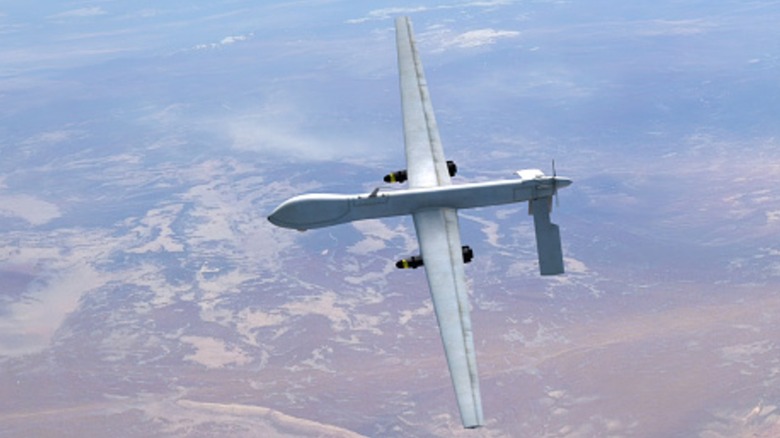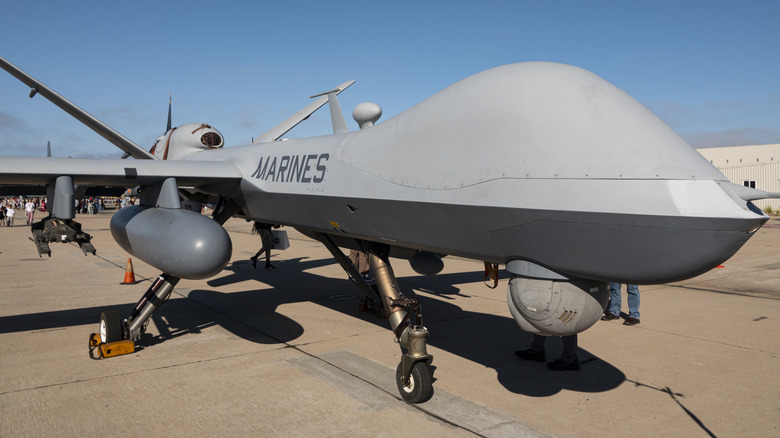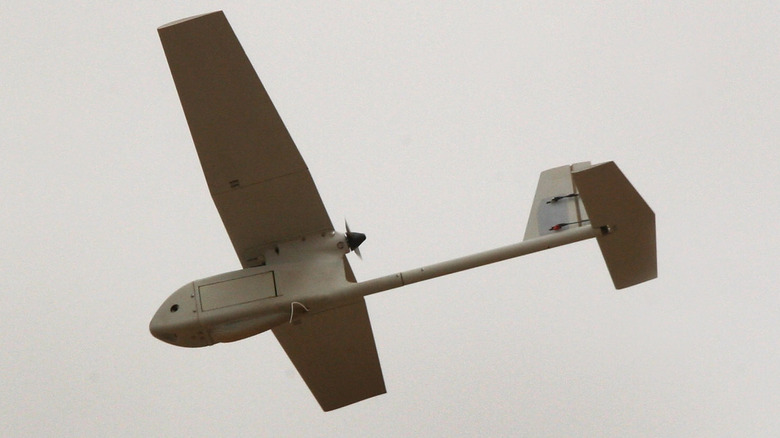How Long Can A Military Drone Stay In The Air Without Landing?
Unmanned aircraft vehicles — UAV for short or drone if you prefer one syllable — provide the military a method for surveilling and striking adversaries without risking a pilot's life. These can take on many shapes and sizes with varying speed capabilities and ranges. The aspect that makes drones especially useful is their flight endurance, the amount of time they can stay in the air. Some smaller drones like the Gleesfun G11 Mini are beholden to their batteries, limiting their endurance. Meanwhile, an MQ-9 Reaper can carry as much as 903 gallons of fuel, keeping it in the air longer than its smaller counterparts.
There are multiple factors at play in determining when a drone needs to finally land, including size, powerplant, and payload. The United States Army tested Airbus' Zephyr 8, a solar-powered drone, and kept it in the air for nearly 35,000 miles, which amounted to 64 days. It took off on June 15, 2022, and didn't come down (crash) until August 18. Before the Zephyr 8, the drones with the longest range were the RQ-4 Global Hawk, with a record-breaking 34.3 hours of flight time in 2014; the MQ-4C Triton, with 30 hours of flight time, and the MQ-9B SkyGuardian.
The SkyGuardian surpasses the former two by several hours, staying in flight without refueling for 40 hours. Of course, none of those drones are solar-powered, so they don't hold a candle to the Zephyr 8.
Other Drones with long flight time
The U.S. armed forces use several groups of military drones, classified as Group 1 through 5 by the Department of Defense. Lockheed Martin built the Stalker VXE drone in the Group 2 classification — a maximum weight of 21 to 55 pounds – that can maintain flight for 39 hours, 17 minutes, and 7 seconds. The United States Air Force Research Laboratory is working with drone maker DZYNE Technologies to develop a Group 5 drone — maximum weight higher than 1,320 pounds with a ceiling higher than 18,000 feet – the Ultra Long-Endurance Tactical Reconnaissance Aircraft, or ULTRA.
The 3,000-pound drone is built for intelligence, surveillance, and reconnaissance tasks, and even while carrying a payload of 400 pounds, it has a flight endurance that exceeds 80 hours. That's nothing compared to AeroVironment's Global Observer that the Department of Defense adopted in 2011. It can get as high as 65,000 feet for reconnaissance and stay up for 168 hours or seven days. It only weighs 350 pounds when empty but has a maximum takeoff weight close to 4,000 pounds.
When it comes down to it, a military drone's flight endurance relies on how much it weighs, how large it is, its payload, environmental conditions, the propulsion system, and fuel capacity. Technology is improving every day, allowing these unmanned vehicles to surpass manned aircraft in multiple ways.
Smaller drones are just as frightening
A lot of the larger Group 4 and 5 drones like the Reaper get a lot of the spotlight — probably because they look cool and can cause tons of damage — but there are Group 1 and 2 drones that are just as effective on the battlefield. Ukraine has been using the R18 octocopter, a drone developed by the Ukrainian NGO Aerorozvidka, since 2014. The drone has been used for nighttime strikes and has proven devastating for Russian forces, targeting military equipment and other strategic targets. It's small and can only stay in the air for 40 minutes, but it can carry up to 11 pounds of free-falling bombs that pack a punch.
The United States, United Kingdom, and a handful of other allies have access to AeroVironment's Raven B RQ-11 drone, a Group 1 drone that weighs 4.4 pounds. It's small enough to be carried on a troop's back and deployed by being thrown like a model airplane. Its 75 minute endurance and three different nose-mounted cameras make it useful for intelligence, surveillance, and reconnaissance missions, delivering real-time color and infrared imagery to the controller.


